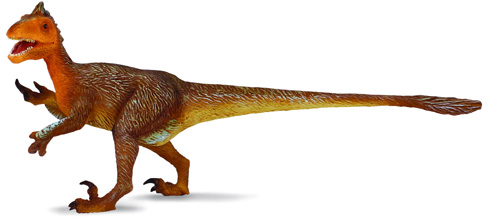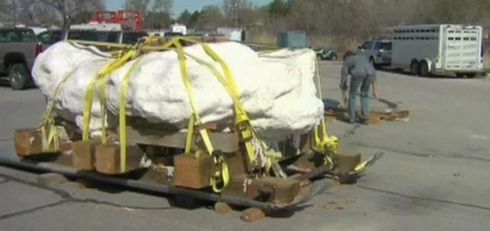Preparation of Stone Block in a Bid to Learn Utahraptor Pack Secrets
In early 2015, Everything Dinosaur team members reported on the excavation and removal of a massive 9,000 kilogramme block from the Arches National Park (eastern Utah). The block contains the fossilised remains of at least six different Utahraptors (U. ostrommaysorum). These were fast and agile predatory dinosaurs that roamed the western United States some 125 million years ago (Early Cretaceous)
Fossils of an iguanodont were also found at this remote location. It has been suggested that the ferocious Utahraptors may have been attracted to the area by the stench of the rotting carcase of this ornithopod. Unfortunately, these creatures seem to have become trapped in soft ground (the same likely fate as their intended iguanodont victim), as a result several specimens have been preserved together.
An Illustration of Utahraptor (U. ostrommaysorum)
Picture credit: Everything Dinosaur
Utahraptor
We think that Utahraptor is the largest member of the Dromaeosauridae family yet described. It may have reached lengths in excess of seven metres or more and palaeontologists hope that these fossils will greatly increase the understanding of Utahraptor anatomy and ontogeny. Ontogeny is the study of how an animal grows. Amongst the fossils documented so far are a number of skulls. These range in size from a little over ten centimetres (a very young animal), to a skull more than six times as big (the skull of a fully grown adult).
The Huge Boulder Wrapped in Burlap and Plaster
Picture credit: ABC News
To read Everything Dinosaur’s original article on the Utahraptor excavation: One Nine Tonne Block = 6 Potential Utahraptors.
Preparing the Fossils
It will take many months to prepare the fossils, extracting them with great care from the surrounding matrix. Their orientation and layout are as important as the fossils themselves. They may provide clues as to the sequence of deposition and possibly reveal evidence of pack behaviour in these very bird-like predators. The removal and transport of such a huge boulder was extremely difficult, especially when the relatively remote location of the Mesa where the specimen is from is taken into consideration. However, the picture above shows the great care taken by Utah’s Department for Natural Resources in order to ensure a happy ending to this highly complicated logistical undertaking.
We await further developments and the publication of scientific papers documenting these fossils over the next eighteen months or so.








Leave A Comment